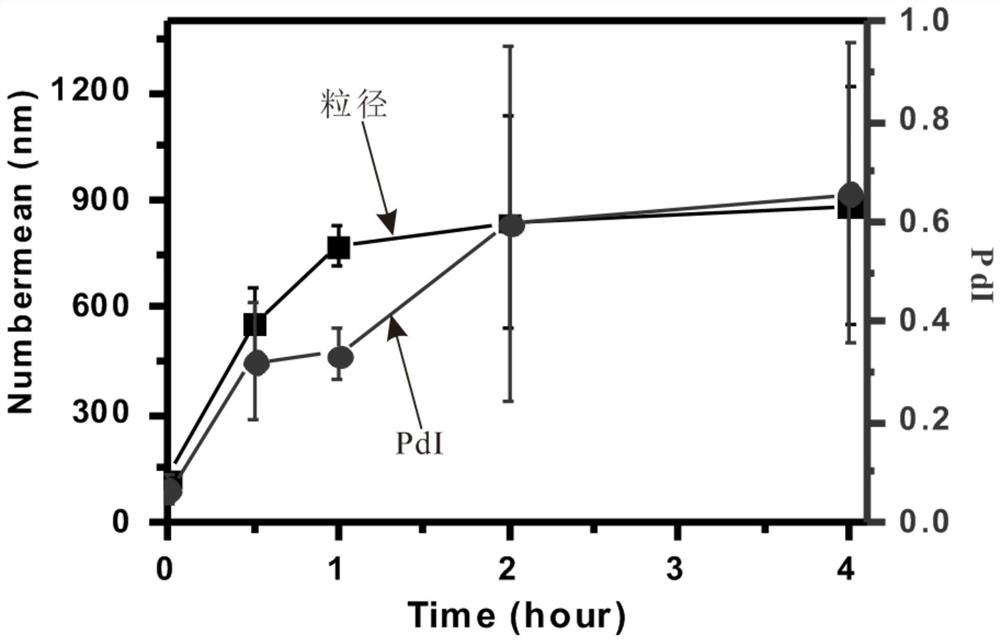A method and application for increasing the level of ROS by promoting the conversion of energy absorbed by photosensitizers into the CET pathway
A photosensitizer and pathway technology, applied in the field of photodynamic therapy, can solve the problems of lack of tumor-specific targeting of photosensitizers, limit the clinical application of PDT, and low ROS, so as to enhance the effect of PDT, inhibit the photothermal transition pathway, and increase the content of Effect
- Summary
- Abstract
- Description
- Claims
- Application Information
AI Technical Summary
Problems solved by technology
Method used
Image
Examples
Embodiment 1
[0038] A method for increasing the level of ROS by promoting the energy absorbed by the photosensitizer into the CET pathway, comprising the following steps:
[0039] (1) Accurately weigh 20 mg of IR780 and dissolve in 2 mL of methanol to obtain IR780 stock solution (10 mg / mL);
[0040] (2) Take 200 μL of IR780 storage solution, and then add 10 μL of BF to it; use ultrasound to mix the two thoroughly, drop them into 5 mL of water, and stir at 40°C for 5 minutes to obtain carrier-free nano-drug (RF) aqueous solution;
[0041] (3) Add 300 μL hyaluronic acid aqueous solution (2 mg / mL) to the RF aqueous solution, and vortex fully to obtain the HA-coated carrier-free nanomedicine (HRF) aqueous solution.
Embodiment 2
[0042] Example 2 Carrier-free nano drug stability and enzyme sensitivity test
[0043] Disperse HRF in phosphate buffered saline (PBS, pH=7.4) and a solution containing 10% fetal bovine serum (FBS), and use DLS to measure the particle size and potential and observe its change. Such as figure 1 As shown, the particle size and potential of HRF did not change greatly in PBS and 10% FBS, which indicated that HRF was relatively stable in the physiological environment.
[0044] Incubate HRF with hyaluronidase (100-250units / mL) at pH = 5.5, 37°C for 4 hours, and use DLS to measure the particle size of the carrier-free nano-drug at 0.5, 1, 2, and 4 hours. The results are shown in figure 2 . Such as figure 2 As shown, after incubation with hyaluronidase, the diameter of HRF increased significantly, and the polydispersity index (PdI) increased from 0.1 to 0.7. This phenomenon can be attributed to the degradation of the HA shell of the nanocarrier by hyaluronidase, which disrupts ...
Embodiment 3
[0045] Example 3 Using computer simulation to verify the self-assembly of fluorocarbon molecules to drive the formation of photosensitizers
[0046] 1. Simulate the self-assembly of IR780 and pentafluorophenyl trifluoroacetate (F) at the ratio of 1:1, 1:5, 1:10 and 1:20 respectively. See the results image 3 -A. In the figure, the dark molecule is IR780 and the light molecule is F. When the ratio was 1:1, F spontaneously formed worm-like nanoparticles to drive the assembly of IR780, forming irregular worm-like nanoparticles. As the proportion of F increases, F molecules first aggregate into spherical nanoparticles, and then drive IR780 to disperse and assemble on its surface.
[0047] 2. Then the ratio of IR780 and F was fixed at 1:20, and a regular scan was performed to explore the dynamic process of self-assembly of IR780 driven by fluorocarbons. The results are shown in image 3 -B. At 0 ps, IR780 and F molecules are randomly distributed in water. Over time, F starts...
PUM
 Login to View More
Login to View More Abstract
Description
Claims
Application Information
 Login to View More
Login to View More - R&D
- Intellectual Property
- Life Sciences
- Materials
- Tech Scout
- Unparalleled Data Quality
- Higher Quality Content
- 60% Fewer Hallucinations
Browse by: Latest US Patents, China's latest patents, Technical Efficacy Thesaurus, Application Domain, Technology Topic, Popular Technical Reports.
© 2025 PatSnap. All rights reserved.Legal|Privacy policy|Modern Slavery Act Transparency Statement|Sitemap|About US| Contact US: help@patsnap.com



